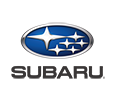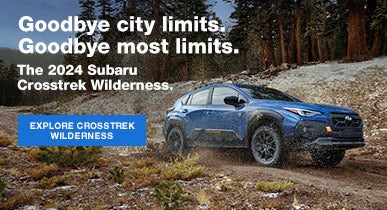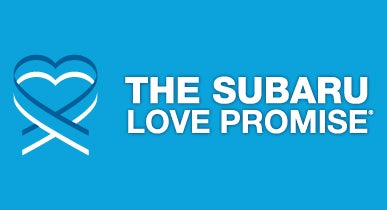Do All 4 Tires Need To Match On An All-Wheel Drive Or Four-Wheel Drive Vehicle?
The ability of a four-wheel drive and all-wheel drive vehicles to divide the engine's horsepower between its four tires is especially useful on loose or slippery surfaces such as sand and dirt, as well as on wet, icy or snow-covered roads. However it's important to remember that in order to transfer this extra power, the four-wheel drive and all-wheel drive vehicle's driveline mechanically connects the tires so they work in unison.
Four-wheel drive and all-wheel drive vehicles are equipped with additional differentials and/or viscous couplings that are designed to allow momentary differences in wheel speeds when the vehicle turns a corner or temporarily spins a tire. However, if the differentials or viscous couplings are forced to operate 100% of the time because of mismatched tires, they will experience excessive heat and unwarranted wear until they fail.
"Using "matched" tires means all four tires are the same brand, design and tread depth. Mixing tire brands, tread designs and tread depths may cause components in the vehicle's driveline to fail."
This necessitates that four-wheel drive and all-wheel drive vehicles use tires that are very closely matched. This is because different diameter tires roll a different number of times each mile as a result of the variations in their circumferences. Tire diameter variations can be caused by accidentally using different sized tires, tires with different tread designs, tires made by different manufacturers, different inflation pressures or even tires worn to different tread depths.
As an example of different tire diameters resulting from tires worn to different tread depths, we'll compare two 225/45R17-sized tires, a new tire with its original tread depth of 10/32-inch and a second tire worn to 8/32-inch of remaining tread depth. The new 225/45R17-sized tire has a calculated diameter of 24.97", a circumference of 78.44" and will roll 835 times each mile. The same tire worn to 8/32-inch of remaining tread depth is calculated to be 1/8" shorter with a diameter of 24.84", have a circumference of 78.04" and will roll 839 times per mile. While the difference of 1/8" in overall diameter doesn't seem excessive, the resulting 4 revolutions per mile difference can place a continuous strain on the tires and vehicle's driveline. Obviously, the greater the difference in the tires' circumferences, the greater the resulting strain.
This makes maintaining the vehicle manufacturer's recommended tire inflation pressures and using "matched" tires on all wheel positions necessary procedures to reduce strain on the vehicle's driveline. Using "matched" tires means all four tires are the same brand, design and tread depth. Mixing tire brands, tread designs and tread depths may cause components in the vehicle's driveline to fail.
Mismatched tires or using improper inflation pressures for all-wheel drive and four-wheel drive vehicles can also result in immediate drivability problems. Some Control Trac equipped vehicles in 4Auto mode may exhibit a shutter on acceleration and/or a noise from the front driveline and transfer case while driving. Some all-wheel drive and four-wheel drive vehicles may exhibit axle windup or binding while driving. Some four-wheel drive vehicles (manual or electronic shift) with a two-wheel drive mode may refuse to shift "on the fly" into 4x4 Auto or 4x4 High at highway speeds.
Rotating Tires
Because the front and rear tires of all-wheel drive and four-wheel drive vehicles perform different duties while accelerating, braking and cornering, tire rotation is important to even out, and maintain equivalent treadwear of all of the vehicle's tires to minimize potential driveline stresses.
If the vehicle is equipped with a matching road wheel and full-sized spare tire, they should be integrated into the vehicle's rotation pattern at the first tire rotation. This will allow all five of the vehicle's tires to share in the workload and wear at similar rates. In the event that a single tire is damaged and has to be removed from service, this will allow the tread depth equivalent spare tire to be used with the remaining three tires.
If the spare is not integrated into the vehicle's tire rotation pattern, it will not match the tread depth of the four worn tires on the ground when called into service. Additionally, if a single tire is replaced by the full size spare tire, hopefully the new replacement tire can remain as the spare tire until the other four tires have worn out and need to be replaced.
Replacing Pairs of Tires or Individual Tires
There are several suggestions that have been offered to drivers who are replacing pairs or individual tires on their four-wheel drive and all-wheel drive vehicles. Some vehicle manufacturers recommend that all tires maintain the same rolling radius and circumference, while others suggest that all tire circumferences remain within 1/4- to 1/2-inch of each other. Other vehicle manufacturers recommend that all four tires remain within 2/32-, 3/32- or 4/32-inch of each other, or within 30% of each other in relative remaining tread depth.
Regardless of the vehicle manufacturer's recommendations, the least stressful application is when all four tires are the same tire brand, tread design and equivalent tread depth.
Before buying pairs or individual tires for all-wheel drive and four-wheel drive vehicles, drivers should read their vehicle's owners manual or contact the dealer's service department for confirmation of their specific vehicle's requirements.
Matching Tires by Shaving Them to Maintain Equivalent Tire Tread Depths
What does a driver do if one tire has to be removed from service when it and the other three tires have already worn to two-thirds to one-half of their original tread depth? Simply installing one new tire runs the risk of drivability problems or expensive driveline damage. Replacing the other three partially worn tires along with the damaged tire significantly increases the cost.
Tire Rack can provide a solution by matching the tread depth of the replacement tire to the tread depth of the partially worn tires that will remain on the vehicle by removing tread rubber from a new tire on a specialized machine that operates as a tire lathe. While this may seem counterintuitive, the value of the mileage sacrificed by the one replacement tire is considerably less than the cost of rebuilding worn driveline components.
Tire Rack has offered a tire shaving service that has been primarily used for preparing competition tires for racetrack use. This same service can also be used to remove tread rubber from new pairs or individual street tires used on four-wheel drive and all-wheel drive vehicles to allow them to match the remaining tread depth of the other partially worn tires that will remain on the vehicle. In addition to providing equivalent tread depth to eliminate driveline stress, shaved tires will also better match the traction and handling qualities of the remaining worn tires.
While the cost of our street tire shaving service will range from $25 to $35 for each tire, it is significantly less than the cost of unnecessarily replacing the remaining two or three good tires with lots of mileage still available from them.
Here are recommendations from some of the manufactures that Tire Rack currently serves for matching the tires used on their four-wheel drive and all-wheel drive vehicles. Additional recommendations from other Original Equipment Vehicle Manufacturers is pending.
Subaru Within 1/4-inch of tire circumference or about 2/32-inch of each other in remaining tread depth.
Tread Shaving Profiles
Tires normally feature rounded profiles across their treads, which typically result in deeper depths in their centers and slightly shallower depths in their shoulders. When Tire Rack shaves one new tire to match the remaining tread depth of used tires that will remain in service on the vehicle, we shave the new tire's tread to maintain the profile and relative depths as when the new tire was originally molded.
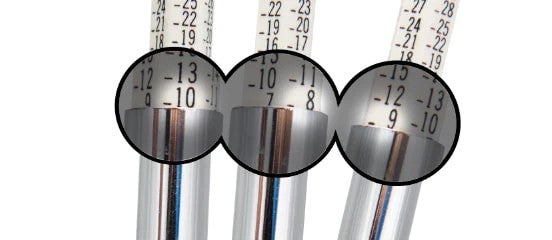
Slightly different beginning tread depths are designed into the shoulder area's circumferential groove, tie bar location and shoulder grooves.
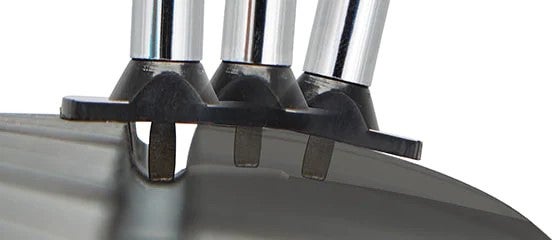
X-ray view of using the tread depth gauge in the shoulder groove area reveals where the tread depths are actually being measured.
As shown in the pictures above, the tire exhibits 10/32" beginning tread depth in its circumferential groove, 8/32" where tie bars raise up to stabilize the shoulder blocks circumferentially and just 9/32" in the lateral shoulder groove. In order to retain the same tread profile, a tire shaved to a requested 7/32" tread depth would exhibit 7/32" in the center circumferential grooves, but about 5/32" at the tie bars and 6/32" in the lateral shoulder grooves.
Single tires being shaved to match existing tires feature a little more of a square cut with the goal of shaving as little rubber off as possible to meet the customer's specified tread depth. And while this will often result in just a little less tread depth in the shoulder area, it will retain the same relative tread depth as when the tire was molded and will continue to distribute the vehicle's load across the tread as originally intended.
Sierra Subaru of Monrovia
735 E. Central AveMonrovia, CA 91016 Driving Directions
| Monday | 7:00AM - 6:00PM |
| Tuesday | 7:00AM - 6:00PM |
| Wednesday | 7:00AM - 6:00PM |
| Thursday | 7:00AM - 6:00PM |
| Friday | 7:00AM - 6:00PM |
| Saturday | 7:00AM - 4:30PM |
| Sunday | Closed |
| Monday | 9:00AM - 8:00PM |
| Tuesday | 9:00AM - 8:00PM |
| Wednesday | 9:00AM - 8:00PM |
| Thursday | 9:00AM - 8:00PM |
| Friday | 9:00AM - 8:00PM |
| Saturday | 9:00AM - 8:00PM |
| Sunday | 10:00AM - 7:00PM |
| Monday | 7:00AM - 6:00PM |
| Tuesday | 7:00AM - 6:00PM |
| Wednesday | 7:00AM - 6:00PM |
| Thursday | 7:00AM - 6:00PM |
| Friday | 7:00AM - 6:00PM |
| Saturday | 7:00AM - 4:30PM |
| Sunday | Closed |
